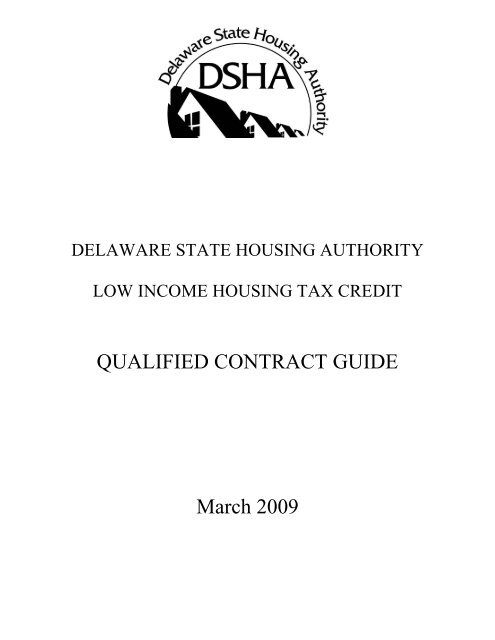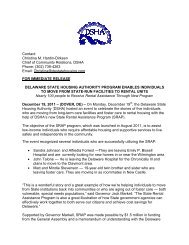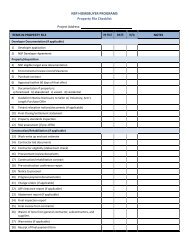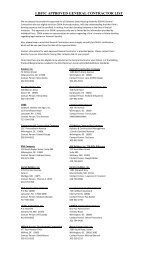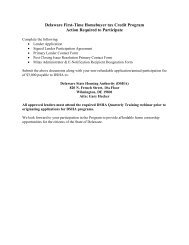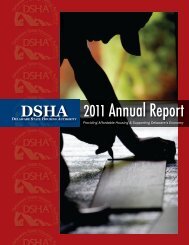Qualified Contract Guide - Delaware State Housing Authority
Qualified Contract Guide - Delaware State Housing Authority
Qualified Contract Guide - Delaware State Housing Authority
Create successful ePaper yourself
Turn your PDF publications into a flip-book with our unique Google optimized e-Paper software.
DELAWARE STATE HOUSING AUTHORITYLOW INCOME HOUSING TAX CREDITQUALIFIED CONTRACT GUIDEMarch 2009
FOREWORD<strong>Delaware</strong> <strong>State</strong> <strong>Housing</strong> <strong>Authority</strong> (DSHA) shall be under no obligation to undertake an investigation ofthe accuracy of the information submitted for a <strong>Qualified</strong> <strong>Contract</strong> (QC) submission. DSHA's review shallnot constitute a warranty of the accuracy of the information, nor of the quality or marketability of thehousing to be purchased, constructed, or rehabilitated pursuant to the program. Developers, potentialinvestors and interested parties should undertake their own independent evaluation of the feasibility,suitability and risk in the acquisition of a development. If any information submitted by a building ownerto DSHA is later found to be incorrect in any material respect, it is the responsibility of the buildingowner to inform DSHA and to request a reexamination of the information. DSHA is not, and is not actingin the capacity of, a real estate agent or real estate broker, tax attorney or tax accountant. Its role is limitedto implementing the Internal Revenue Code (Code) requirements and facilitating the submission of a QC,as defined in the Code. Interested parties should obtain advice from independent sources, includingconsultation with knowledgeable tax professionals and legal counsel. This guide has not been reviewed orapproved by the IRS and should not be relied upon for interpretation of federal income tax legislation orregulations.3
QUALIFIED CONTRACTSection 42(h)(6)(E)(i)(II) of the Internal Revenue Code created a provision that housing credit agenciesrespond to the request for submission of a qualified contract for tax credit developments with expiringcompliance periods. The request for submission of a qualified contract may occur after year 14 of thecompliance period. The request for submission of a qualified contract is a request that the housing creditagency find a buyer (who will continue to operate the property as a qualified low-income property) topurchase the property for a qualified contract price (QCP) pursuant to IRS regulations. If the housingcredit agency is unable to find a buyer within one year, the extended use period is terminated.Many owners have chosen to waive the right to request a qualified contract and have committed theirdevelopments to thirty years or more of operation as low-income rental housing. Owners should reviewthe respective <strong>Qualified</strong> Allocation Plan, tax credit application, carryover agreement, and Declaration ofLand Use Restrictive Covenants of the development to determine whether the development has waivedthe right to request a <strong>Qualified</strong> <strong>Contract</strong> prior to contacting the DSHA.A Request for <strong>Qualified</strong> <strong>Contract</strong> may be submitted only once for each development. If an owner rejectsan offer presented under the <strong>Qualified</strong> <strong>Contract</strong> or withdraws its request at any time after the NotificationLetter and Application Materials have been received by DSHA, no other opportunity to request a<strong>Qualified</strong> <strong>Contract</strong> will be available for the development in question.A. QUALIFIED CONTRACT PROCESS1. Owners who are contemplating requesting the submission of a <strong>Qualified</strong> <strong>Contract</strong> should contactthe DSHA Tax Credit Compliance Coordinator. DSHA will verify the development’s eligibility.2. If the property is determined eligible to request a <strong>Qualified</strong> <strong>Contract</strong>, DSHA will send a letter ofacknowledgement to the owner along with:(a) <strong>Qualified</strong> <strong>Contract</strong> Notification Letter.(b) <strong>Qualified</strong> <strong>Contract</strong> Process <strong>Guide</strong> and related Application Materials.(c) Current year dates when requests for <strong>Qualified</strong> <strong>Contract</strong>s will not be accepted by DSHA.3. The Tax Credit <strong>Qualified</strong> <strong>Contract</strong> request will assign an underwriter to work with the Owner todiscuss issues pertinent to the development and possible alternatives to the qualified contractprocess. Owners should be prepared to present a thorough analysis of all current financing andrelated restrictions.4. If a property is not eligible to request a <strong>Qualified</strong> <strong>Contract</strong>, DSHA will issue the owner a letter ofdenial.B. QUALIFIED CONTRACT NOTIFICATION LETTERThe next step in the process for requesting a <strong>Qualified</strong> <strong>Contract</strong> is to submit the <strong>Qualified</strong> <strong>Contract</strong>Notification Letter, along with all required Application Materials. This request may be submitted any timeafter the fourteenth year of the compliance period.The Notification Letter contains statements from the owner that the owner will reasonably cooperate withDSHA and its agents with respect to the marketing of the property, and acknowledges that theApplication Materials may be shared with prospective purchasers, real estate brokers and other interestedparties and that summary data may be posted on DSHA’s website.4
Owners will be asked to acknowledge in the Notification Letter that they have reviewed the due diligencematerials used in the calculation of the qualified contract worksheets and that they are solely responsiblefor documents and information used in the calculation of the <strong>Qualified</strong> <strong>Contract</strong> Price, using theprocedure set forth in Section 42(h)(6)(F) of the Internal Revenue Code. The owner will be asked in thenotification letter to sign a statement verifying the accuracy of the assumptions used in the computation ofthe <strong>Qualified</strong> <strong>Contract</strong> Price and to hold DSHA harmless with respect to the use of the developmentinformation.Additional information may be requested by DSHA, including but not limited to, additional rent rolls,income certifications and other Section 42 compliance records, records with respect to repair andmaintenance of the development, operating expenses and debt service. Before information is shared witha prospective purchaser, the owner may require that the Agency and/or the prospective purchaser enterinto a commercially reasonable form of nondisclosure agreement.The owner shall also be asked by DSHA to share, upon request, the documents and other information thatwere used to prepare the Calculation of <strong>Qualified</strong> <strong>Contract</strong> Price (QC-1). The owner will be asked toallow DSHA, its agents, or prospective purchasers, upon reasonable prior written notice, to visit andinspect the development, including representative apartments units.C. APPLICATION MATERIALSThe <strong>Qualified</strong> <strong>Contract</strong> Notification Letter must be submitted along with the following materials from theowner:1. A thorough narrative description of the development, including all amenities, suitable forfamiliarizing prospective purchasers with the development.2. A description of all income, rental and other restrictions, (including easements and deedrestrictions) if any, applicable to the operation of the development.3. A detailed set of photographs of the development, including the interior and exterior ofrepresentative apartment units and buildings, and the development grounds. Digital photographsshould be included so that they may be easily displayed on DSHA’s website.4. A copy of the most recent 12 months of operating statements for the development which willfairly apprise a potential purchaser of the development’s operating expenses, debt service, grossreceipts, net cash flow and debt service coverage ratio; along with the three most recent annualaudited financial statements.5. A current rent-roll.6. All years of tax returns for the Partnership.7. A copy of the development Limited Partnership Agreement.8. Disclosure of Rights of First Refusal, if any.9. If any portion of the land or improvements are leased, copies of the leases.10. A physical needs assessment.11. A fully completed “Calculation of <strong>Qualified</strong> <strong>Contract</strong>” Price (form QC-1),including Worksheets A – E (see Section D for a brief description of these worksheets), alongwith copies of the documents and other information used to support the <strong>Qualified</strong> <strong>Contract</strong> Price.This form must be completed and certified by a Certified Public Accountant.12. A <strong>Qualified</strong> <strong>Contract</strong> processing fee of $5,000 payable to DSHA.5
D. CALCULATION OF QUALIFIED CONTRACT PRICE WORKBOOKForm QC-1 contains accompanying worksheets A-E, as described below:Worksheet A: Outstanding Indebtedness, a summary of all outstanding secured indebtedness on thelow-income building(s).Worksheet B:Calculation of Adjusted Investor Equity in the low-income building(s), by year.Worksheet C: Other Capital Contributions made by the investor in the low-income portion of thebuilding(s). These are contributions that are not included in other calculations, specifically in the“Outstanding Indebtedness” or “Adjusted Investor Equity” worksheets.Worksheet D: Cash Distributions from, or available from the development, by year. This calculationalso includes a reporting of the cash held in reserve.Accounts and Partnership Accounts. Also included here are non-cash distributions that have been madeby the owner. These non-cash distributions will not be applied to reduce the “qualified contract price” butmust be reported.Worksheet E: Fair Market Value on non-low-income portion of the building(s). This worksheet requiresan appraisal, study or methodology proof or other support used to establish the market value of the nonlow-incomeportions of the building(s).E. REVIEW PROCESS1. Upon receipt of the owner’s Notification Letter and Application Materials, DSHA will have 60days to review the owners’ packet of due diligence materials for completeness. DSHA will sendthe owner a letter acknowledging that all notification requirements have been met.2. After DSHA has received all required documentation, DSHA will have 60 days to validate the<strong>Qualified</strong> <strong>Contract</strong> Price (QCP) proposed by the Owner. This will require DSHA and the ownerto work closely together to ensure that an appropriate QCP has been set.3. Once the QCP has been approved, DSHA will notify the owner that the one-year period to find aprospective buyer for the development has begun.4. During the one-year period, DSHA will advertise the property in good faith. DSHA’s process toidentify an interested purchaser may include, but not be limited to:(a) Post the property information on DSHA’s website.(b) Put together an informational flyer and send to a pre-established mailing list. This list willinclude owners of tax credit properties; contacts at large management companies; other publicfunding agencies in the state; local, state and nation-wide nonprofit and for profit ownersinterested in preserving housing; and tax credit investor contacts.(c) Present information on the property to regional development groups, preservation groups andother stakeholder meetings that DSHA attends.(d) Act as a conduit for all requests of prospective purchasers by quickly responding to requestsfor additional information from the owner and forwarding that information immediately uponreceipt.6
F. COMPLETION OF QUALIFIED CONTRACT PROCESS1. If DSHA has identified a prospective purchaser, it will present to the owner, a qualified contractas defined in IRC Section 42(h).2. If the owner accepts and the property is sold, owner will notify DSHA of the transfer ofownership by submitting the Notice of Intent to Transfer Ownership or Change Owner Name orStatus along with accompanying documentation.3. If DSHA is unable to locate a purchaser who will continue to operate the property as lowincome,the owner will be notified that the extended-use period will terminate. However,pursuant to IRC Section 42(h)(6)((E)(ii), existing residents will continue to have the right torent at the restricted rent levels and may not be evicted or have tenancy terminated for otherthan good cause for a period of three years following the termination of the extended useperiod. During this 3-year period, owners are required to annually submit the Tax CreditSummary Report (LIHTC 13) to DSHA listing all low-income households that occupied a unitat the termination of the extended use period, the respective tenant-paid rent, utility allowance,and move-out date, if applicable, along with a certification that no low-income residents havebeen evicted or displaced for other than good cause. This report and certification will be dueannually on January 15 th or the next business day. No monitoring fees will be due during this3-year period and DSHA is not required to perform inspections.FEES AND CHARGESThe fee for processing a <strong>Qualified</strong> <strong>Contract</strong> request is $5,000. The fee must be submitted at the time the<strong>Qualified</strong> <strong>Contract</strong> Notification Letter is presented to DSHA, and is nonrefundable.All charges incurred by DSHA, including, but not limited to, for submission materials, appraisals, marketstudies, legal, and rent comparability studies will be borne by the owner.7


